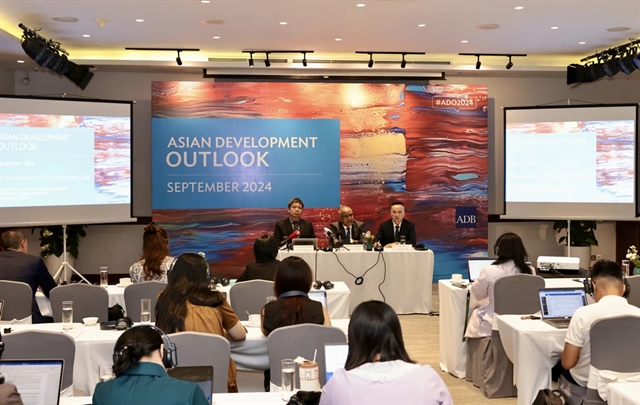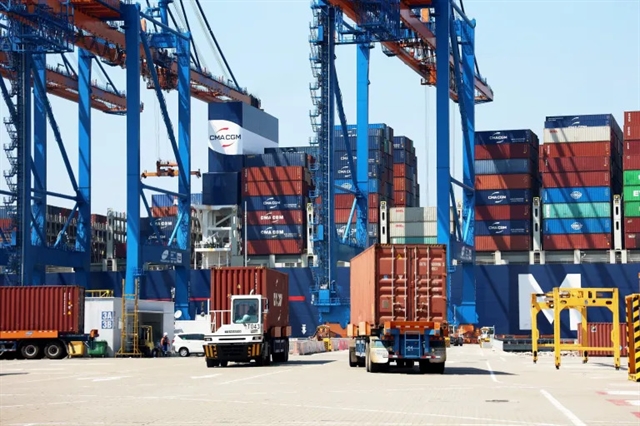 Economy
Economy

 |
| International organisations have praised Vietnam’s economic performance, with some revising their forecast upward. In the picture: The Asian Development Bank (ADB) releases its report on Việt Nam’s and Asia’s economic development for 2024-2025 on September 25, 2024 in Hà Nội. — VNA/VNS Photos |
HÀ NỘI — Prime Minister Phạm Minh Chính has instructed ministries, agencies, and local authorities to drastically and effectively implement three strategic breakthroughs, six key tasks, and 12 primary solutions, striving for double-digit growth in 2025, set to be the year of acceleration and breakthroughs, and laying the foundation for the 2026-2030 socio-economic development plan.
Groundwork for growth
With various achievements and crucial foundations established, 2024 serves as a pivotal year for Việt Nam's economic advancement.
Despite the severe impact of super typhoon Yagi and global economic volatility, Việt Nam’s economy demonstrated its resilience in the year, with its GDP growth surpassing 7 per cent, ranking among the few nations with high growth rates regionally and globally.
International organisations have praised Việt Nam’s economic performance, with some revising their forecasts upward. Notably, Standard Chartered raised its forecast for Việt Nam's economic growth in 2024 to 6.8 per cent, VinaCapital predicted the GDP growth to remain at 6.5 per cent for both 2024 and 2025, the Hong Kong-Shanghai Banking Corporation (HSBC) increased its growth forecast to 7 per cent, and the International Monetary Fund (IMF) adjusted its projection to 6.8 per cent. The national brand value reached US$507 billion in 2024, ranking 32nd out of 193 countries, up one spot from 2023. Business confidence is rebounding and economic outlook remains rosy.
Inflation was kept at below 4 per cent, a remarkable achievement given wage increases starting July 1, 2024, and price adjustments for certain goods and services.
Foreign trade was a standout success, serving as a key driver of economic growth. Total import-export turnover hit a record of nearly $800 billion, up 15 per cent from the previous year and nearly three-fold over the assigned target.
“The structure of exports continues to improve positively, with reduced raw materials and increased processed and industrial products, enabling deeper integration into global production and supply chains," said Deputy Minister of Industry and Trade Phan Thị Thắng.
Việt Nam maintained a trade surplus for the ninth consecutive year, reaching nearly 25 billion USD. This boosted foreign exchange reserves, stabilised exchange rates, and reinforced macro-economic stability. Industrial production saw a strong recovery, with an impressive growth rate of 8.4 per cent, with manufacturing and processing up nearly 10 per cent, providing significant momentum for macro-economic development.
With the signing of the Việt Nam-UAE Comprehensive Economic Partnership Agreement (CEPA) in a record 16 months, Việt Nam has integrated more intensively into the global economy.
Amid challenging circumstances, fiscal and monetary policies have played a vital role in economic development. Tax and fee reduction and exemption for 2024 and 2025 have significantly supported production and business activities, creating jobs, controlling inflation, stabilising the economy, and ensuring social welfare.
 |
| Container trucks operate at Gemalink, the largest deep-sea container port in the southern province of Bà Rịa-Vũng Tàu’s Phú Mỹ town. |
The Ministry of Finance introduced incentives to help remove difficulties for enterprises and citizens with total funding of VNĐ191 trillion ($7.5 billion) in 2024. The total state budget revenue exceeded VNĐ2 quadrillion, up 19.1 per cent from the projection and 15.5 per cent from 2023.
“Over the past four years, the state budget revenue has consistently exceeded the previous year by over VNĐ1 trillion. This is a great effort and a success in fiscal policy management. Thanks to that, we have more resources to invest in airports and sea ports, and implement infrastructure projects such as the North-South Expressway as well as social welfare policies," according to Deputy Prime Minister Hồ Đức Phớc.
Monetary policy management also contributed to stabilising the macro-economy, controlling inflation, supporting liquidity for credit institutions, and reining in money and foreign exchange markets.
Accordingly, the State Bank of Việt Nam created favourable access to bank loans, which restored production and business, and contributed to promoting growth associated with stabilising the macro-economy, controlling inflation, and ensuring the safe operation of credit institutions. According to reports from commercial banks, lending interest rates have continued to decline by approximately 0.96 per cent per year compared to late 2023.
Prioritising growth acceleration
PM Chính emphasised that 2025 is a year of acceleration and breakthroughs, striving to achieve the highest possible results for the targets and indicators set in the 2021-2025 plan while also undertaking organisational restructuring. During this streamlining process, tasks must continue to be promoted, implemented, and completed, and once completed, work must resume immediately. The restructuring aims to reduce staffing levels, cut recurring expenses—which currently account for about 68 per cent of total budget expenditures—and eliminate overlaps in the functions of ministries and agencies.
Minister of Planning and Investment Nguyễn Chí Dũng highlighted the focus on leveraging growth poles, economic corridors, and dynamic zones to create spillover effects nationwide. He also called for exploring new economic models and industries to drive growth.
The State Bank of Việt Nam said that it will manage interest rates in line with market and macro-economic developments, as well as inflation and monetary policy targets. It will closely monitor the market situation to manage exchange rates, and coordinate monetary policy tools, which would contribute to controlling inflation and stabilising the macro economy. The central bank will also direct credit institutions to ensure safe and efficient credit growth, focusing lending on production and business sectors, priority areas, and key growth drivers in line with the policies of the Government and the PM. — VNS



